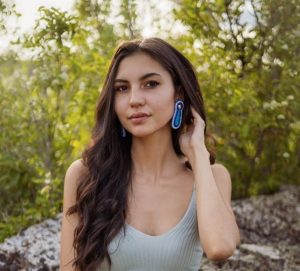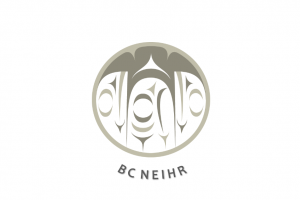The BC NEIHR is working to give Indigenous leaders in community, wellness, research, and health a voice by conducting spotlight interviews on the wonderful work being conducted. The first of these spotlight interviews can be found below with Sage Flett Kruger, an Indigenous woman of the Okanagan Nation working with Trails BC to create a more inclusive and safe space for Indigenous people.
Interview by Laine Grace, Interior IHRF

Can you please start off by quickly introducing yourself and your role?
Sage:
Wai, Husk’al’hault, incha iskwist Sage Flett Kruger. I’m speaking to you today from my traditional territory of the Okanagan Nation. I am the Indigenous engagement manager for Trails BC.
What projects/work/ideas /events are you working on right now that you are most excited about?
Sage:
The project I am most excited about right now is our Tmixw Trails program. This program was developed to engage and inspire Indigenous youth and families to participate and be active on trails throughout the Okanagan territory. The premise is holistic learning, engaging, walking tours of trails for participants. Included in the tour we have Elders and/or knowledge keepers telling traditional stories in relations to the lands we are touring. This would include the use of both English and Nsyilxcen (Okanagan) languages. There are additional fun components including actives such as bird/plant bingo.
What inspired you to do this amazing work?
Sage:
In our culture, land and health are closely linked. Land is the ultimate nurturer of people. It provides not only physical but emotional and spiritual sustenance. It inspires and provides beauty. It nurtures our souls. We, in turn, have a reciprocal duty as stewards of the land.
There are times when it feels like Indigenous persons are unseen or overlooked when planning is done by municipalities, regions, districts, etc. Trails BC, however, is actively working to create a diverse and inclusive space for all people to enjoy being active on trails in the region. I was pleased to be hired on as the Indigenous Engagement manager to facilitate the creation of programs dedicated to Indigenous peoples and having a space to feel safe and connected with one another.
Can you speak more about your role with Trails BC and what it means to you?
Sage:
I am not an Indigenous Health Researcher, however my role as Indigenous Engagement Manager for Trails BC is directly related to community and individual wellness. More often, in the mainstream, health is measured using a variety of health indicators that do not always reflect Indigenous wellness indicators. Holistic well-being in our community includes mental, emotional, spiritual and physical factors. On a community level, we consider the abundance of language speakers as an indicator of wellness. Handing down our traditional stories and traditional knowledge impacts our wellbeing. Our Tmixw project touches on a balance of many of these factors.
Inviting our Indigenous community members to participate in the Tmixw Trails program may provide an opportunity for our youth to feel seen and heard and to ask questions related to the territory. Having Elders participate and feel safe and comfortable enough to share their stories, all of these things are vital to our community wellness.
Do you feel your upcoming events/work/ideas benefits community wellness? Or how do you envision it benefiting individuals and communities?
Sage:
Land is what sustains us physically, emotionally, spiritually, and mentally. A holistic vision of wellness includes activity and walking trails are a perfect setting. Values that support and uphold wellness include Respect, Wisdom, Responsibility and Relationships. The connecting factor is to include a diverse age group. By doing this work we hope to empower our youth to connect more with Elders and Knowledge Keepers from the community.
Can you explain the importance of these Trails events being ‘Indigenous only’ spaces?
Sage:
Having a program that is only focused on Indigenous people creates a safe space for our youth, Elders, and other community members to be fully present with one another and to embrace our Indigenous roots. Where we are underrepresented or feel unwelcome it is unlikely that we will participate. Getting our community members on or off reserve and out onto trails they may not have explored before can provide a balance between physical, emotional, mental, and spiritual wellness.
Why are these trails projects important for Indigenous communities, collectives, and organizations / what benefit will these projects have to health and wellness?
Sage:
Maintaining a healthy, balanced life as well as showing leadership through modelling wellness and healthy behaviours will be the take-away from out program. We intend to create a program that will become a model/template we can us and implement it in other areas throughout BC.
Have you received funding to do this work? If so from where?
Sage:
Yes, we are grateful for the generous support from the Stober Foundation.
Is there anything else you would like to share about your work?
Sage:
Trails BC is also working on a project called The Great Blue Heron way. It is a project to connect First Nation communities with active transportation routes for safe and accessible transportation for people from these communities along with people who have disabilities and others, as well as people who may not have access to vehicles or are not able to afford other transportation.
In Metro Vancouver, Tsawwassen Elder Xwasteniya (Ruth) will lead the development of a First Nations vision for the Great Blue Heron Way working with the Indigenous youth we will hire to engage other First Nations. This will help re-establish traditional linkages between Coast Salish communities and reframe the lens of trails and active transportation to incorporate Indigenous perspectives and contemporary and historical understandings of the land.
What advice would you give other communities planning projects like yours?
Sage:
Wellness starts with individuals who then influence their families, who then influence their communities, who in turn influence their regions. Outreach to your communities is key. Having collaborative group talks with the youth. Elder’s, leadership. Getting to feedback from your community will always help your project and build relationships. Make sure the communities you are working within are represented in your decision-making process. Cultural safety is an outcome based on respectful engagement that recognizes and strives to address power imbalances inherent in the many mainstream systems. Ensure your environment is free of racism and discrimination. Respect is about honouring where we come from: our cultures, traditions, and ourselves. Wisdom includes knowledge of language, traditions, culture, and medicine.
https://infotel.ca/newsitem/trails-bc-project-bringing-inclusivity-to-syilx-youth/it88112


